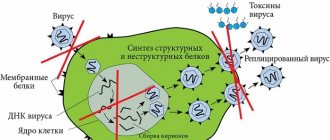Pharmacodynamics and pharmacokinetics
Misoprostol is a synthetic derivative of prostaglandin E1 . It is capable of inducing contraction of the smooth muscles of the myometrium and dilation of the cervix, which facilitates the process of excretion of the contents of the uterine cavity. Due to its weak stimulating effect on the smooth muscles of the gastrointestinal tract, large doses inhibit the secretion of gastric juice , and the tablets act as an antiulcer agent .
Misoprostol as an active substance does not have a significant clinical effect on:
- prolactin;
- gonadotropin levels ;
- thyroid-stimulating hormones;
- growth hormones;
- thyroxine;
- cortisol;
- creatinine;
- platelet aggregation.
Pharmacokinetics
Oral administration leads to rapid absorption (max concentration - 6.08±1.64 mg/ml). When taken with meals, especially fatty ones, the bioavailability of the drug decreases without affecting the duration of absorption. In the walls of the gastrointestinal tract and liver, conversion occurs to the active diesterified metabolite - misoprostolic acid , the maximum concentration of which is reached after half an hour and is 499 mg/ml.
The half-life is no more than 30 minutes; the substance does not accumulate in body tissues and is excreted primarily by the kidneys.
Misoprostol helps with stomach ulcers
In light of alarming events in the world, in individual territories, even within small societies, a person can succumb to specific damaging influences that negatively affect not only the emotional (mental) state, but also his internal organs.
Thus, many people who actively lead their lives need to be vigilant during the initial assessment of the state of the body
It is important not to succumb to stressful situations, eliminate negative emotions, overcome internal tension, otherwise ulcers cannot be avoided. The main organ that courageously fights these troubles is the stomach.
Such diseases of the stomach and duodenum will immediately manifest themselves through severe constant pain that is difficult for the patient to bear. Often, chronic disease of the digestive tract is the consequence of an imbalance in the stomach (the organ’s protective mechanisms are lost, the secretion of hydrochloric acid increases). It is not necessary to endure, suffer, and endure incipient diseases on your feet; you need to understand that small troubles will be followed by more serious problems, leading to fatal consequences
It is important to seek qualified help in a timely manner, get tested, undergo research and get the correct diagnosis. Only strictly following the recommendations of specialists, following the indicated treatment methods, will the healing process be successful and in the shortest possible time
But learning about current trends in the treatment of ulcers using proven drugs will not be superfluous, in some cases it is even vital. Among the most effective drugs is Misoprostol (Cytotec), which is a non-steroidal anti-inflammatory drug. Recent medical trials and practical experience in using the medicine have proven its effectiveness in the fight against diseases of the gastrointestinal tract. From the name it is clear that the main active substance is Misoprostol. It is this that affects the processes of blood flow to the mucous membranes of all organs of the tract, improving the production of protective mucus. Then all that remains is to follow the doctors’ recommendations so that the body copes with the disease, healing ulcers and remnants of erosions.
For complete preventive measures for gastric (duodenal) ulcers, non-steroidal anti-inflammatory drugs will help first of all. The pharmacological effect is a cytoprotective effect on the mucous membranes of the affected organs. Thanks to the balanced composition of the drugs, it is possible to influence the cells of parietal organs and limit substances not activated by histamine. In turn, this affects the power, frequency of impulses (contractions), and stimulation of the drug on the smooth muscles of the entire gastrointestinal tract.
Using data from specialized resources will allow you to obtain verified information about the effectiveness of modern medicines, take note of interesting material, and only after consultation with your doctor begin active treatment of the established disease.
All articlesNext article
Indications for use
- erosions , as well as erosive and ulcerative lesions of the gastrointestinal tract due to therapy with other drugs and prevention of their ulcerogenic effects (for example, prevention and treatment of NSAID gastropathy );
- peptic ulcer of the duodenum and stomach , including exacerbations;
- for early pregnancy of amenorrhea ).
special instructions
Misoprostol tablets for termination of pregnancy in the early stages must be used simultaneously with mifepristone. The procedure can only be performed in specialized medical institutions that have the capabilities to provide emergency surgical blood transfusion and gynecological care.
Before taking the drug, the patient's condition should be monitored for 4-6 hours. After using Misoprostol, in cases of massive bleeding or the development of other complications, qualified medical care should be provided.
In approximately 80% of women, after taking Misoprostol, a miscarriage occurs within 6 hours, in 10% - within 7 days.
8-15 days after using the drug, you should undergo a re-examination in the same medical institution. If necessary, an ultrasound is performed or the level of human chorionic gonadotropin in the blood serum is determined. If you suspect continued pregnancy or an incomplete abortion, you need to conduct a comprehensive medical examination in a timely manner. If the diagnosis is confirmed 10-14 days after taking Misoprostol, it is necessary to conduct vacuum aspiration followed by histological examination of the aspirate in order to assess the effect of the drug on the formation of congenital malformations in the fetus.
Impact on the ability to drive vehicles and complex mechanisms
Since dizziness and other side effects that negatively affect concentration and speed of psychomotor reactions may occur after taking the drug, caution should be exercised when driving vehicles.
Contraindications
- hypersensitivity to the drug, as well as to other prostaglandins and analogues;
- liver dysfunction;
- cardiovascular or endocrine diseases;
- diabetes;
- severe form of renal failure ;
- contraindications for the use of prostaglandins – bronchial asthma , glaucoma , arterial hypertension ;
- reception of VPZ ;
- inflammatory processes in the intestines , including enteritis ;
- pregnancy , suspected ectopic pregnancy , lactation (breastfeeding);
- age group up to eighteen years.
Drug interactions
Please note that when combined with misoprostol:
- Magnesium-containing antacids – contribute to increased diarrhea provoked by the drug;
- Isoniazid, rifampicin, anticonvulsants, cimetidine, antacids, antidepressants, indomethacin, acetylsalicylic acid and phenobarbital drugs reduce the level of misoprostol in the blood.
Misoprostol aggravates the adverse reactions of indomethacin and diclofenac, and reduces the anticoagulant effect of acenocoumarol.
Side effects
In relation to various organs and systems, Misoprostol can cause the following adverse reactions:
- Gastrointestinal organs: abdominal pain , dyspepsia , flatulence , nausea , vomiting , diarrhea or constipation .
- Genitourinary system: various disorders of the menstrual cycle, postmenopausal bleeding from the vagina, hypermenorrhea , dysmenorrhea , heavy uterine bleeding , pain in the lower abdomen , most often caused by contractions of the myometrium. In the pre- and postmenopausal period - convulsions .
- Cardiovascular system: hypo- or hypertension .
- Skin: rash , itching .
- Allergic reactions and angioedema .
- Other reactions: dizziness , headaches , asthenia , changes in body weight, hyperthermia and/or chills .
Possible complications and side effects
Complications from taking Misoprostol are rare, but there is a risk. These include:
- Vaginal bleeding – this may be excessive and require vacuum aspiration and sometimes a blood transfusion;
- Continuation of pregnancy - in this case, a surgical abortion is necessary, since there is a high probability of serious pathologies in the fetus.
In some cases, side effects may occur, which include the following:
- Vomiting and nausea are regarded as adverse reactions as a result of taking medications. In this case, it is necessary to stop the nausea by taking the appropriate medicine, for example “Cerucal”;
- Dizziness – it is not necessary to treat, this is a consequence of the medications taken;
- Diarrhea - manifests itself as a response to taking Misoprostol and goes away on its own without treatment;
- Elevated temperature is due to the effect of this drug on the thermoregulatory center. The fever lasts 2 hours, then the temperature returns to normal. To reduce it, antipyretics are used. If she hasn’t fallen after 4 hours, you need to see a doctor.
- Feelings of pain are associated with increased tone of the uterus. In this case, thermal procedures, taking anti-inflammatory drugs (diclofenac, ibuprofen), and paracetamol are indicated.
Instructions for Misoprostol (Method and dosage)
Misoprostol for abortion in combination with Mifepristone is taken according to the following scheme:
- 3 tablets (600 mg) of Mifepristone - orally on an empty stomach or two hours after a meal.
- After 36–48 hours - 2 tablets on an empty stomach. (400 mcg) Misoprostol.
Attention! If after taking there is no bleeding for 2 days, then taking the pills on your own is prohibited. To prescribe an additional dosage, you should consult a doctor - visit an obstetrician for 2-3 days.
Instructions for the use of Misoprostol as an antiulcer drug involve taking the tablets orally with meals. Dosage: 200 mcg 3-4 times a day, a single dose in the range of 200-400 micrograms, if the patient has hypersensitivity or renal failure - the dose is 100 micrograms. How to take it and for how long should be calculated depending on the indications and the observed clinical picture of treatment.
Release form and composition
The drug is produced in the form of tablets: round, white (3 pieces each in aluminum blisters with aluminum coating, 1 blister and instructions for use of Misoprostol in a cardboard box).
1 tablet contains the active substance - misoprostol powder HPMC (hydroxypropyl methyl cellulose) in a ratio of 1:99:
- Misoprostol – 0.2 mg;
- Hypromellose – 19.8 mg.
Auxiliary components: sodium carboxymethyl starch, microcrystalline cellulose, castor oil, colloidal silicon dioxide.
During pregnancy and lactation
Based on the type of effect on the fetus, the drug is classified in category (according to the FDA) - X.
Misoprostolic acid can pass into breast milk. Despite the fact that there is no information on the development of any adverse reactions in children, it is recommended to use Misoprostol during lactation with caution.
If the drug is used as:
- Gastroprotective agent: pregnancy or planning it is unacceptable, since increased uterine tone can cause miscarriage . The drug can be prescribed only after pregnancy test Taking Misoprostol is usually started 2-3 days after the start of the menstrual cycle ; a prerequisite is the use of reliable methods of contraception , for example, barrier ones.
- Uterotonic: use for the purpose of termination of pregnancy, otherwise the drug is contraindicated in case of planned pregnancy.
Precautionary measures
In accordance with the instructions, Misoprostol without Mifepristone cannot be used to terminate pregnancy. Taking this drug may cause fetal death or birth defects. When using Misoprostol in the 1st trimester, the likelihood of the following birth defects increases:
- limb deformity;
- development of the Mobius sequence (eg, palsy of the VI and VII cranial nerves);
- arthrogryposis.
Taking pills at a later stage increases the risk of uterine rupture, especially in cases where the patient has had uterine surgery or is currently in a multiple pregnancy.
When prescribing medications to terminate a pregnancy, it is important that the woman uses these pills under the supervision of a doctor in gynecological hospitals. They have the ability to provide emergency surgical or blood transfusion assistance if necessary.
Attention! If a woman has a negative Rh factor, then it is necessary to use drugs to prevent the development of Rh conflict in subsequent pregnancies, as with a conventional surgical abortion.
Reviews of Misoprostol
Reviews about Misoprostol can be found absolutely varied. Many note the drug as an effective means for terminating pregnancy, although they complain about side effects and negative consequences after use.
Pencrofton and Misoprostol are used in combination for medical abortion , but it must be supervised by medical staff and supervised by a doctor. In addition, medical specialists usually prescribe Misoprostol for the treatment of erosive and ulcerative lesions of the gastrointestinal tract and to prevent the ulcerogenic effects of other drugs.
How to use the drug to terminate a pregnancy?
Instructions for use of Misoprostol:
"Misoprostol" for termination of pregnancy is used in combination with "".
In the process of taking medications, bleeding should appear and as a result a lump resembling a clump of cotton wool should come out - the fertilized egg. 3 or 5 days after the procedure, an ultrasound examination is performed, with the help of which the effectiveness of termination of pregnancy is assessed.
Medical abortion should be performed in a clinical setting under the supervision of a specialist
, since unforeseen circumstances may arise in the form of complications, in which case emergency specialized care will be required.
conclusions
It is impossible to perform a medical abortion with prostaglandins alone, just as nothing will work with the wrong dosage.
Self-administration of medications for medical abortion will result in serious complications
To terminate a pregnancy without complications, you need to see a gynecologist and undergo an ultrasound to determine the timing. Two weeks after the abortion you need to be examined again.
What else you should know
Taking prostaglandins increases the effectiveness of antiprogesterones only if you stop taking painkillers. Analgesics significantly reduce the contractility of prostaglandins, doctors know this, so they ask the woman to be patient.
If you ignore this feature, there is a risk that the dead embryo will remain inside the uterus and will not come out, provoking severe inflammation and bleeding.
It is prohibited to use pills for pharmacological abortion at home because without an ultrasound it is impossible to find out what kind of pregnancy is occurring: uterine or ectopic.
In case of ectopic pregnancy, drugs are ineffective. Their impact is fraught with severe bleeding and contraction of the uterus, but pregnancy will continue, creating a risk of rupture of the fallopian tube. If the process drags on, the woman is guaranteed surgery to remove the organ.
Cost of some services in our clinic
| Medical abortion MIROPRISTONE (all medications, appointment with a gynecologist, ultrasound included) | 4500 rub. |
| Gynecologist appointment | 1000 rub. |
| Control ultrasound after medical termination of pregnancy | 1000 rub. |
| Gynecological ultrasound (pelvis) using Doppler techniques (transabdominal and transvaginal) | 1200 rub. |
VIEW ALL PRICES
UP
Share link:
When can misoprostol be used for abortion?
It is better not to use it for abortions in the following cases:
- After the first trimester of pregnancy (after 12 weeks, and it is most effective before 9 weeks)
- For possible ectopic pregnancy
- If you have an intrauterine device (IUD)
Misoprostol may be used in other cases, such as:
- Late (second trimester) termination of pregnancy. Research has shown that misoprstol may be effective during this period. And although it is better to use it with mifepristone, if it is not available, misoprostol is also a good alternative
- Treatment of incomplete miscarriage
- Labor stimulation for late abortions (third trimester)
- Induction of labor during full-term pregnancy











